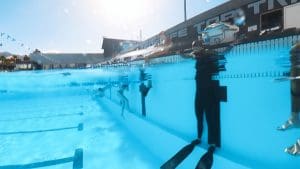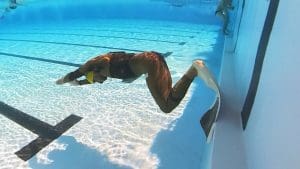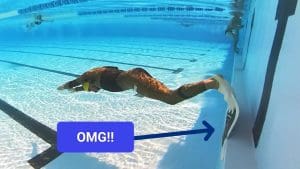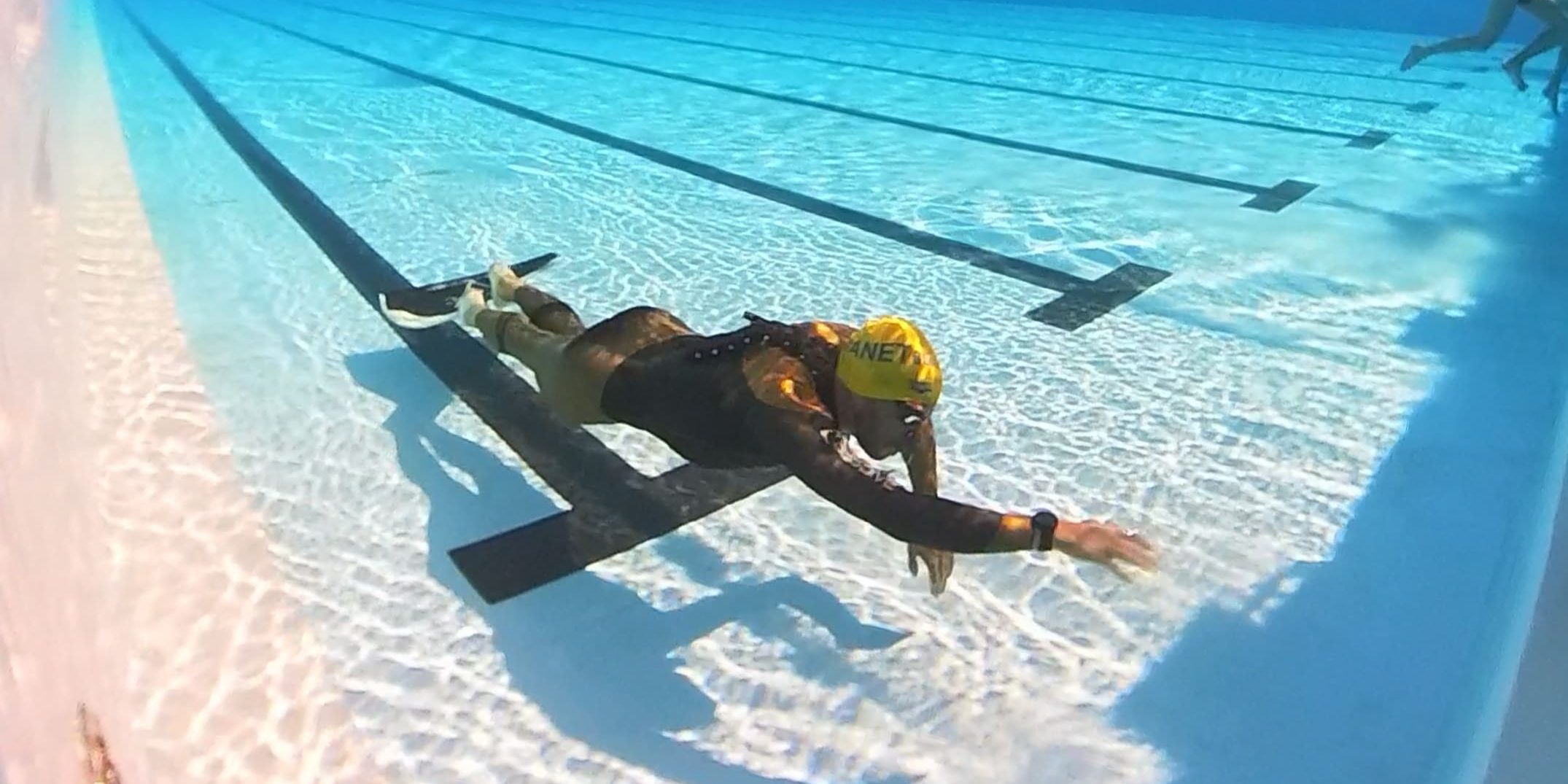Dynamic Apnea: Buoyancy Blunders and Other Sinful Mistakes
(This one is not a funny one, I’m sorry. While writing this I identified with one (or all) my old school teachers and my sense of humour temporarily left my body. Apologies.
If you are reading my blog, you are probably someone who has watched at least some dives during the latest CMAS pool world championship in Greece. And if you are a semi-serious pool freediver you must have noticed how many people were not weighted correctly and swimming at a 45 degrees angle trying to stay down (among other ominous things). You may have asked yourself why someone performing at a high level ends up making such silly mistakes.
As someone who has fucked up a series of things during world championships, and missed a number of podiums because of this, I feel entitled to have an opinion, so here you go.
I’m not a pool expert by any means, in fact my pool training experience is almost entirely directed to train for depth performance, and I’m a bit embarrassed to admit that have done only 4 pool competitions to date. However, due to my detail-oriented personality and slight OCD tendencies I have a habit of putting a lot of thinking into every little thing I do, so below my recommendations when it comes to pool competition preparation.
Whenever you go to a pool competition, there are a few things you need to have sorted before D-day (unless the competition is held in the same pool where you usually train). A new pool will have different characteristics, which you must take into consideration and probably need to change some things in your set up because of them. In particular: depth, water level, (possibly) length, lane dividers, turning walls, pool tiling and bottom markings.
On big competitions such as World Championships, you generally have some training days preceding the official start, and many people make the mistake of “training” during this time. DONT! All your training is already done and if it is not, there is nothing else you can do to improve your performance 24 hours before official top! You need to use this time to fix your set up! Why? you may ask: I have the same suit, and I do the same amount of packs, for which I need the same amount of weights as usual. NOPE!
So what do I need to fix?
(This will sound obvious to a lot of people, but it may be completely new to others – usually to those ending up floating like corks).
– Depth of the pool: if you train in a 1.5 meters pool and you are now competing in a 2.5m pool there will be a difference in your buoyancy: normally you will have a preference about how far you want to be from the bottom; this means that if you keep the same distance as usual, you will now be 1 full meter deeper than usual….Do you not think that’s affecting your buoyancy? Of course it is, and BIG TIME. If you swim at a deeper depth, you will be heavier, which means you need to remove weights or pack more to compensate for the buoyancy change.
-Water level on your body when taking the last breath: if you normally have the water level just below your chin when taking the last breath, you will inhale less air than if the water was at your chest level. When changing pools, you need to account for this, and if you blindly inhale and pack the same amount as usual your buoyancy will be off. This is another reason why you should check buoyancy again and you may realize you can pack a lot more (or less) depending on how much above or below the surface your chest will be.

-Lastly, something that many people don’t consider is that your buoyancy is not the same for DNF as it is for bifins or monofin. Fins can be buoyant or negative and you need to compensate for that. So, if you compete in all 3 dynamic disciplines you need to check your buoyancy separately for each and you may need to add or subtract weights or move weights around along your body for different disciplines.
Once your buoyancy is fixed, there are a few more things you need to figure out:
-Turns: how are the walls, are there steps in the middle of the wall (the answer is always yes in 50m pools)? How high are the steps and will you need to turn above or below the step? Usually it’s not a huge deal for DNF (except for the clumsiest of us, who will always find a way to fuck that up by going too high and finding that they are further from the wall when it’s time to kick off), but it can be tricky when you are wearing fins especially if you turn by pushing off the wall and you risk breaking your blade against the sharp edge. Practice many turns, above and below the evil step, until you figure out what works best for you.

Doesn’t look so bad, but….

you dont want your blade bending there!
-Floating pool dividers: you may be used to training in a pool with very tight lane lines and that’s great since you can easily support surface after surfacing from a dive. Some other pools may have dividers with a lot of slack, so when you hold on to them you will sink, and it will be hard to stay afloat and be stable. This happened at the last World Championships, a lot of people were struggling to find support, and I believe many of them ended up blacking out or disqualifying themselves by dipping because of that. I also noticed that some people were hopelessly trying to stand on the bottom for support, probably because they train in shallow pools and are used to that, but when diving in a deep pool that is not an option. This, in combination with the sloppy divider, caused some severe booboos. So, the thing to do when trying a new pool is to practice exiting the water to check the stability of the lane line, but don’t do that too close to the walls, as usually that is the most stable part: do it in the middle of the pool length, where there is slack on both sides of the divider. (I don’t know how many times I wrote divider in the last paragraph but it’s way too many, I think I made my point by now).
-Tiling material and colours: most pools have nice ceramic tiles and that’s great. Anything else is immoral and should be illegal, like the pool where I train, which has what I call “Velcro walls.” You wouldn’t believe me if you never dived in a such a pool, but the wall literally SUCKS YOU BACK when you try to push off. It’s because of a special voodoo rubbery coating that acts as a potent magnet between your blades and the wall, and it’s horrible! So, if you do a push off turn you need to do so with the inner part of your footpockets, so the flat part of your blade doesn’t get contact the wall. It is not a great looking turn and probably not as streamlined, but the only other option is to change your turn style (to the non-push off) but that usually requires some time to get used to. If you only do DNF this will not affect you. As if that wasn’t bad enough, these voodoo pools have painted blue lines, which fade away with time and exposure, and you can literally miss the T and bang your head against the wall, or at the very least fail to time your turn correctly, especially if you dive without goggles.
If you are unlucky enough to be competing in one of these pools, don’t forget to find a turn strategy that suits you, and keep your goggles on (and maybe ask the organisation to add weighbelts on the bottom to mark the T.)
If given the opportunity to try the pool before the start of the comp, use all the time you need to fix all this. However, during small competitions you may not have the luxury of trying the pool the days previous, which means your only chance to sort this out is during your 45 minutes warm up before your dive. Which sucks. Many people don’t even want to touch water before their official top in the belief it will mess with their dive reflex. But I warmly recommend you don’t miss the chance to try your set up before your dive!
Finally, you thought you adjusted your buoyancy and started your dive, but then you realize you fudged it and are all over the place? Yeah, it happens, and it sucks and yes you will be utterly upset with yourself for a few seconds, but if you have enough awareness to know if you are floating or sinking, you can still do small things to at least patch it up. Are you floating up? Try to swim as close to the bottom as possible to lose some buoyancy. If that alone doesn’t fix it, exhale a little mouthful of air and see if that helps. If instead you are sinking, go a little higher and see if that makes you gain enough positive buoyancy to compensate for it.







